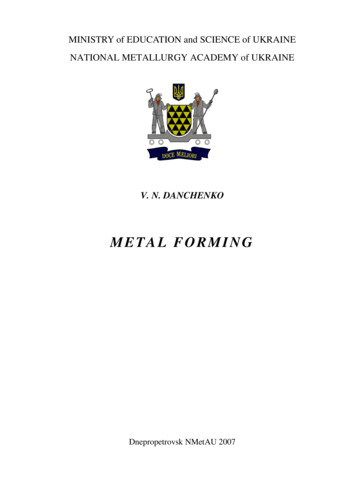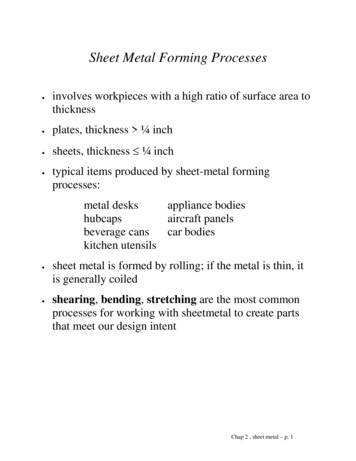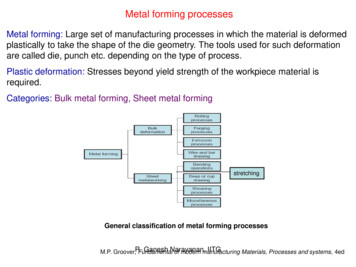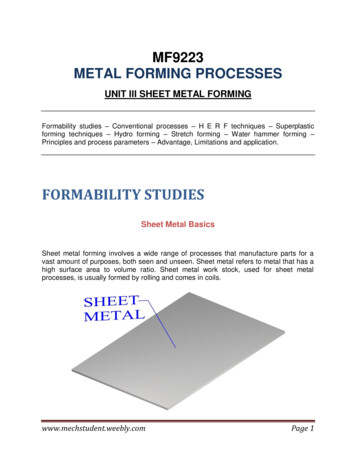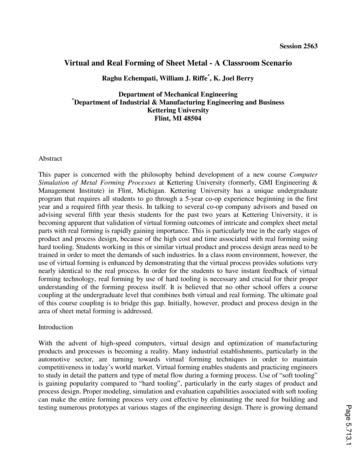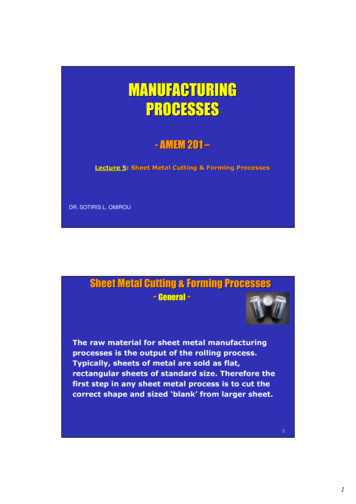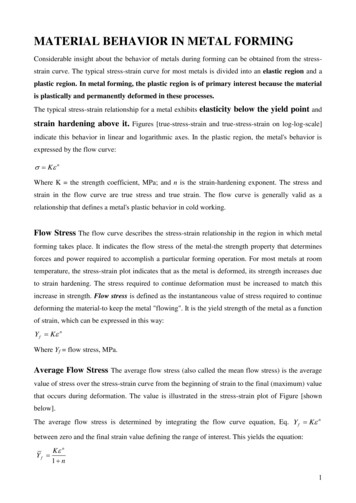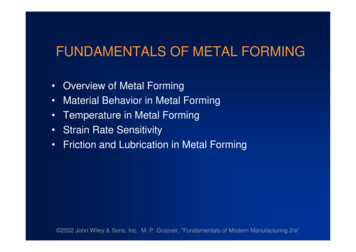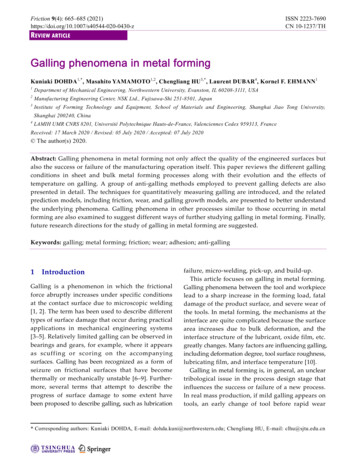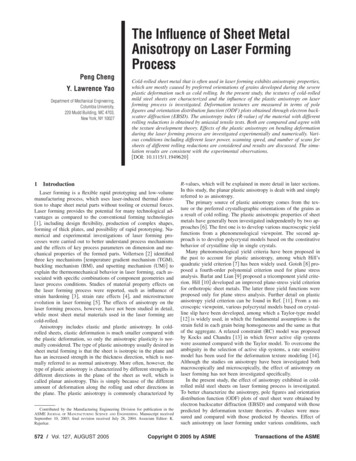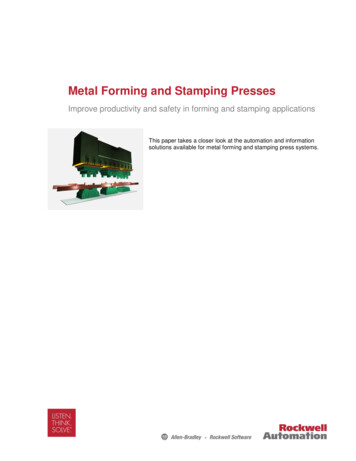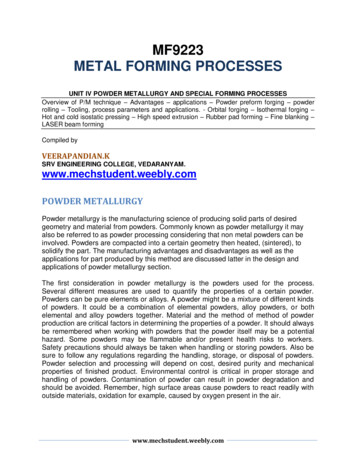
Transcription
MF9223METAL FORMING PROCESSESUNIT IV POWDER METALLURGY AND SPECIAL FORMING PROCESSESOverview of P/M technique – Advantages – applications – Powder preform forging – powderrolling – Tooling, process parameters and applications. - Orbital forging – Isothermal forging –Hot and cold isostatic pressing – High speed extrusion – Rubber pad forming – Fine blanking –LASER beam formingCompiled byVEERAPANDIAN.KSRV ENGINEERING COLLEGE, VEDARANYAM.www.mechstudent.weebly.comPOWDER METALLURGYPowder metallurgy is the manufacturing science of producing solid parts of desiredgeometry and material from powders. Commonly known as powder metallurgy it mayalso be referred to as powder processing considering that non metal powders can beinvolved. Powders are compacted into a certain geometry then heated, (sintered), tosolidify the part. The manufacturing advantages and disadvantages as well as theapplications for part produced by this method are discussed latter in the design andapplications of powder metallurgy section.The first consideration in powder metallurgy is the powders used for the process.Several different measures are used to quantify the properties of a certain powder.Powders can be pure elements or alloys. A powder might be a mixture of different kindsof powders. It could be a combination of elemental powders, alloy powders, or bothelemental and alloy powders together. Material and the method of method of powderproduction are critical factors in determining the properties of a powder. It should alwaysbe remembered when working with powders that the powder itself may be a potentialhazard. Some powders may be flammable and/or present health risks to workers.Safety precautions should always be taken when handling or storing powders. Also besure to follow any regulations regarding the handling, storage, or disposal of powders.Powder selection and processing will depend on cost, desired purity and mechanicalproperties of finished product. Environmental control is critical in proper storage andhandling of powders. Contamination of powder can result in powder degradation andshould be avoided. Remember, high surface areas cause powders to react readily withoutside materials, oxidation for example, caused by oxygen present in the air.www.mechstudent.weebly.com
Powder PropertiesPowders are finely divided solid particulates. The size and shape of individualparticulates is important. Characteristics of a powder can be quantified in several ways.These characteristics are necessary to understand when selecting a powder for anoperation. since powder properties will effect processing factors.Size And DistributionSize of particles is a factor that will effect processing of metal powders. Powders arecommonly measured using a series of screens with different sized openings. Eachscreen is a wire mesh with openings ideally of the same size. Screens for powdermeasurement are designated according to the number of openings per linear inch, (i.e.30, 100). Openings per linear inch are the same in the 2 dimensions of the screenssurface, therefore the number of openings per square inch is the square of the linearnumber. A screen with a linear measurement of 100 has 100 2 or 10,000 openings persquare inch. When determining the size of an opening the size of the screens wire mustalso be considered. Mesh opening size, (MS), can be determined byMS 1/MC - W S, where MC is the mesh count, (openings per linear inch), and W S is thethickness of the wire.www.mechstudent.weebly.com
These screens are stacked one over another with the screen with the largest openingson top. As the stack progresses downward each sequential screen has a smalleropening than the one above it. A powder sample is poured on the top screen. Amachine vibrates the stack. Powder particles will fall through the screen openings untilthey encounter a screen size too small to fit through. Thus, each screen will collectmetal powder particles of a certain size range. The sizes and distribution of sizes canthen be measured. For example the particles that pass through 90 but not 100 are saidto have a size of 90-100, they may also be considered to have a size of 90. With thismethod, particle size distribution can be measured, usually by weight percent, andquantified. Results can be represented graphically, the size range in which the highestweight percent of particles occur is called the mode size.This system does have limitations. Imperfect screens can result in variations in the sizeof openings. Differently shaped particles also effect the accuracy of the powderscreening technique. The difficulties involved in manufacturing screens increase as thenumber of openings per inch increases. For this reason powder particle sizemeasurement using screens is limited to a lower range of about 400 opening per linearinch. Very small powder particles tend to agglomerate or stick together, which wouldmake the metal powder screening method ineffective at extremely low ranges anyway.There are several other methods by which particle size can be determined. Particles aresuspended in a liquid medium and can be measured by light scattering techniques or byelectrical sensors. Measurements can be made with a microscope. Other types ofoptical analysis may be used. X-ray measuring techniques are available. Sedimentationis also a method to measure powder particle size and distribution. Sedimentationdetermines size by measuring the sinking of a particles in a liquid.www.mechstudent.weebly.com
Particle StructureThe structure or shape, of particles is a major factor in a powder processing operation.Material and method of powder production are the main variables determining powdershape. Particles of a certain powder may have similar shapes but no particle shapes areexactly the same. Hence, there will exist a shape distribution within a powder. Differenttypes of powders combined together may also have significant differences in particleshape, which will show in the shape distribution.Particle shape plays a large roll in powder density and flow characteristics, it is also amajor factor in pressing and sintering. There are several types of basic powder particleshapes. These are ideal shapes, particles in reality are imperfect and may exhibitcharacteristics of more than one shape type.PorosityPores or space within the powder is in a large part determined by particle shape, (andsize), since the shape dictates how particles will contact each other. Spaces that existbetween particles of a powder and are open to the outside are called open pores. Thesespaces expose external surfaces of powder particles.www.mechstudent.weebly.com
During compaction of powder these spaces are eliminated. If a certain amount of thisspace remains after processing, it will result in porosity in the part. These open poresare permeable to the atmosphere. They are also permeable to fluids in general, such asliquid lubricants, water, or melted polymers, provided that the porous regions areinterconnected and not isolated. The other type of vacancy that exists in a powdermaterial is called a closed pore. These pores are not open to the outside atmosphere.Closed pores can develop during the pressing and sintering process if an open poreregion becomes closed off. Another type of closed pore exists within the material of thepowder particle itself. Theoretically if all the open pores, and closed pores wereeliminated the density would be that of the fully dense material.Figure:324Friction And Flow Of PowdersThe ability of a powder to flow will differ depending upon the properties of that powder.Material flow will involve movement of particles over one another. Factors determiningthe ability of a particular powder to flow are particle size, particle size distribution,particle structure, particle surface, presence of moisture, material(s), and lubrication.Characteristics that decrease inter-particle friction will tend to increase a powder's abilityto flow.Better ability to flow is usually preferred for a manufacturing powder. More ability to flowresults in faster powder flow rates. Faster rates will decrease die filling time, providing ahigher production rate. Powder flow is important during the compaction of the part.Powder with poor flow characteristics may result in uneven compaction, meaningwww.mechstudent.weebly.com
greater compaction of powder in some areas and less in others. Thus causing densityvariations within the pressed part. One way to measure flow rate is a flow meter. A flowmeter is essentially a conical funnel with a wide opening on top and a smaller openingon the bottom. A certain amount of powder is poured into the funnel and gravity causesthe powder to gradually flow downward through the funnel. Flow meter sides are set ata certain angle. The time that it takes for all the powder to flow through the flow meter ismeasured and flow rate is computed. This is a relative measurement to other powders.Friction is an important consideration and has a large effect on flow and compaction. Asmentioned friction tends to decrease powder flow ability. Friction occurs between thesurfaces of the powder particles. Friction also occurs between the particles and theequipment. Lubrication is used to reduce friction. Excessive friction can impede theconsolidation of the powder resulting in disproportionate compaction, density, andporosity in the work. Smaller particle size usually results in greater friction. Generally,particles with spherical shapes exhibit lower friction, and friction increases as the shapebecomes less spherical. One test for friction is to pour powder from a container througha narrow opening onto a flat surface, forming a pile. The angle between the side of thepile and the surface is considered. Greater angles will indicate more friction within thepowder.www.mechstudent.weebly.com
Powder ChemistryChemical composition of the powder should be known. Powder chemistry is a majorfactor in process design. Individual particles must be examined. Metal powders can be apure element, a mixture of different elemental particles, or the particles themselves canbe an alloy material, called pre-alloyed. Powder metallurgy is unique in its ability to alloyor combine materials that otherwise could not be produced by any other method. Oftendifferent materials are powdered and combined as powders. In this case individualpowder particles will be all of one type of material or another. The particles will havedifferent characteristics as well. The alloying of metal powders of different materialsoccurs latter during the sintering of the part. Sometimes nonmetallic powdersparticularly ceramic powders are mixed and combined with other materials.Chemical composition of the powder can typically be determined using standard testingprocedures. Some tests unique to powders may also be used. For example, an ironpowder may have an unknown percent of iron oxide, (Fe 2O3). A test sample of the ironpowder is taken and exposed to a stream of hydrogen. Weight loss that occurs in thesample is measured. From this, the percentage of iron oxide present in the powder canbe calculated.Surface chemistry of powder is critical, due to the high surface area to weight ofpowders. Oxides may form on particles and should be avoided. Organic materials orsilica can develop surface films on powders. Moisture can permeate through open poresand substances within the water can react with particle surfaces creating films. Surfacefilms are undesirable in manufacturing powders. Typically they are rubbed off by particlemotions during compaction, and form inclusions in the material.www.mechstudent.weebly.com
Surface AreaSurface is measured by considering the combined surface area of all the particles andrelating that to the volume of powder, (usually cm2/g). Powders have an extremely highsurface area to volume ratio. Surface area to volume increases as particle sizedecreases. Particle shape also is a factor in surface area. The higher the surface areathe more activity that will occur during sintering. There are advantages anddisadvantages to increased surface area of powders. Increased surface area willincrease the area for oxides and other surface films to develop. Also agglomeration, orthe sticking together of powder particles tends to occur in smaller sized particles.Smaller particles are advantageous in that they provide more uniform materialdistribution in the process, and better mechanical properties in the product.Bulk DensityBulk density is the density of the powder in its loose, uncompressed form. A container ofknown volume is filled with the powder. The powder is then weighed, and the density isdetermined, usually expressed in g/cm3. Major factors determining bulk density of apowder are particle size, particle size distribution, and particle shape.True density of a material would be the density of the mass if the powder particles weremelted and formed into a single piece. During the compression stage the particles arereshuffled, becoming generally closer together as inter-particular pores are eliminated.As the powder is compressed its density increases. In order to process a powder to itstrue density all porosity open and closed must be eliminated. The difference betweenopen and closed pores is discussed above under porosity. Conventional powderprocessing does not achieve elimination of all porosity. Several special powderprocesses, discussed latter, attempt to produce parts closer to 100% true density.Packing factor is the bulk density of the powder divided by the true density of thematerial. Common packing factors might be .5 or .7. Porosity indicates the amount ofempty space within the material. Porosity is expressed as the percentage of totalvolume that is empty.Compressability, Compactability, And SinterabilityCompressability indicates the relative ability for a powder to compress. For example,lubricants can improve compressability. Compactability is not the same ascompressability. Compactability is a measurement of the structural strength of acompacted, unsintered powder, (called a green compact). Binders, for example, canincrease the compactability of a powder. Sinterability is the ability of powder particles ofthe green compact, to bond together when heated during the sintering process.www.mechstudent.weebly.com
Sinterability is dependant to a large extent on surface characteristics of the powderparticles.Powder ProductionThe production of powder of different materials is an essential first step in powdermetallurgy. Method of production is important, different powder materials are produceddifferently. Particle structure characteristics such as size and shape will also bedependent on production method. Some materials are produced with more than onetechnique. Industrial manufacturers that produce powders are usually different thanthose involved in powder part manufacture. Atomization is the most popular method ofpowder production. Other methods include reduction, carbonyl decomposition,precipitation from solution, mechanical, condensation, and electrolic deposition.Mixing Of PowdersBefore processing it is desirable to create a homogeneous or uniform distribution of allthe different material constituents within the powder mass. Uniform distribution ofpowder particles is important in helping to obtain uniform density within the processedpart. Constituents within a powder material ready for processing can include, powdersfrom one or more materials, lubricants, deflocculates, and binders. Lubricants improveflow characteristics of powder particles, deflocculates help stop agglomeration ofparticles, and binders help improve compactability.Blending is different from mixing as it is in reference to uniformly distributing particles ofthe same material. Blending achieves uniform size and shape distribution of particleswithin a powder. Mixing refers to combining and homogeneously distributing particles ofdifferent materials. Individual powder materials are often blended first then mixed withother powders. Mixing is performed by a variety of mechanical methods. Commontechniques are rotating containers such as drums or cones, and stirring mechanisms.www.mechstudent.weebly.com
Containers are usually less than half full of powder during mixing. Mechanisms aredesigned into the mixing containers to prevent free fall of powder. Vibration of powderduring mixing should also be avoided. Free fall and vibration of powder will causesegregation of particles, which is the opposite of uniform distribution. Amount of timethat powder is mixed will depend on specific factors. Powder mixing time could be onthe order of minutes or days, an hour is an approximate typical mixing time in industrialpowder processing. Length of time should be sufficient to achieve uniform distribution ofmaterials, but should not be longer than needed. Over mixing can decrease particlesize, alter particle shape, and work harden particles. Atmosphere is also sometimescontrolled during mixing to help avoid contamination such as forming of oxides ofparticlesurfaces.Super alloys and other materials that have a low forgeability, can create difficultiesduring a forging operation. Also, mechanical properties of some metals may vary greatlyover small temperature ranges. To help eliminate some of the problems associated withforging these types of materials, particularly with regard to more complex parts,isothermal forging may be employed. This process is also called hot die forging.www.mechstudent.weebly.com
Making Powder-Metallurgy Partswww.mechstudent.weebly.com
Powder rollingSinteringSintering fabrication of Metal Matrix Composites is a process, in which a powder of a matrixmetal is mixed with a powder of dispersed phase in form of particles or short fibers forsubsequent compacting and sintering in solid state (sometimes with some presence of liquid).Sintering is the method involving consolidation of powder grains by heating the “green”compact part to a high temperature below the melting point, when the material of the separateparticles diffuse to the neighboring powder particles.In contrast to the liquid state fabrication of Metal Matrix Composites, sintering method allowsobtaining materials containing up to 50% of dispersed phase.When sintering is combined with a deformation operation, the fabrication methods are called: Hot Pressing Fabrication of Metal Matrix Compositeswww.mechstudent.weebly.com
Hot Isostatic Pressing Fabrication of Metal Matrix CompositesHot Powder Extrusion Fabrication of Metal Matrix CompositesHot Pressing Fabrication of Metal Matrix CompositesHot Pressing Fabrication of Metal Matrix CompositesISOTHERMAL FORGINGIsothermal forging is a hot working process that attempts to maintain the work piece atits maximum elevated temperature throughout the entire operation. This is achieved byheating the die to the temperature of, or slightly below the temperature of the startingwork piece. As forces exerted by the die form the work, cooling of the work piecebetween the mold work interface is eliminated, and thus flow characteristics of the metalare greatly improved. Isothermal forging may or may not be performed in a vacuum.Equipment costs for this manufacturing process are high, and the added expense of thistype of operation should be justified on a case by case basis.www.mechstudent.weebly.com
ORBITAL FORGINGOrbital forging is a manufacturing process by which a part is held in a mold cavity andformed by compressive forces applied through the upper die. The upper die applieswww.mechstudent.weebly.com
these forces as it travels an orbital path. This upper die revolves on an inclined axis,and thus through its revolution it will only apply force to a small portion of the work at atime. Forging force will be administered to the entirety of the work with the completion ofa revolution of the upper die on its inclined orbit.The advantage of orbital forging, (similar to other incremental forging processes), is thatsince only a portion of the work is formed at a time, lower forces are required to performthis process. Another advantage is that this forging technique does not produce a lot ofnoise. Typically in manufacturing practice 10 to 20 revolutions of the upper die will beneeded to forge a part. Conical and disk shaped parts such as gears are commonlymanufactured by orbital forging.ISOSTATIC PRESSINGIsostatic pressing is a powder processing process that falls in the category of formingunder the general category of manufacturing processes. (0r)Isostatic pressing is the powder compaction method involving applying pressure frommultiple directions through a liquid or gaseous medium surrounding the compacted part.www.mechstudent.weebly.com
There are 2 types of isostatic pressing processes: Hot isostatic pressing (HIP), where components are loaded into a furnace andthen placed in a pressure vessel so that heat and pressure can be appliedsimultaneously .Cold isostatic pressing (CIP), where powder is sealed in a flexible mould and isthen subjected to a uniform hydrostatic pressure without heating.Hot isostatic pressingHot isostatic pressing (HIP) is used, as indicated, to press and sinter simultaneously inan inert atmosphere (usually using Argon gas). The powder in the hot isostatic pressingprocess has to be protected from the atmosphere so that oxide films can be avoided.Hot pressing needs the powder to be heated, pressurised and cooled in the protectiveatmosphere.Hot isostatic pressing (HIP) involves isostatic pressing conducted at increasedtemperature.As a pressure medium a gas (Nitrogen or Argon) is used.The work pressures, which are applied in the hot isostatic pressing method, arecommonly between 15,000 psi to 44,000 psi (100 MPa to 300 MPa).Hot isostatic method (HIP) combines pressing and sintering, causing consolidation ofpowder particles, healing voids and pores. The part shrinks and densifies, formingsound high strength structure.www.mechstudent.weebly.com
Cans made of stainless steel, or mild steel are used in the method.The method may be used without a mold. In this case the part is first compacted by coldisostatic pressing method, and then it is sintered in order to close the interconnectingporosity. The sintered (but still porous) part is then pressed isostatically at hightemperature without any can (mold).Cold isostatic pressingCold isostatic pressing is used to produce green compacts which typically will requirefurther processing stages.Cold isostatic pressing (CIP) is conducted at room temperature.A flexible (commonly polyurethane) mold immersed in a pressurized liquid medium(commonly water) is used in the cold isostatic pressing method (see the scheme below):There are two types of cold isostatic pressing: wet bag and dry bag.In the wet bag method the mold is removed and refilled after each pressure cycle. Thismethod is suitable for compaction of large and complicated parts.In the dry bag method the mold is an integral part of the vessel. The dry bag method isused for compaction of simpler and smaller parts.www.mechstudent.weebly.com
The cold isostatic pressing (CIP) method has the following advantages as compared tothe die cold pressing method: better uniformity of compaction; more complex forms (for example long thin-walled tubes) may be compacted;Both processes are expensive from an operating cost perspective but HIP should beconsidered a very expensive option, the need for a protective environment and the slowcycle time of the process leads to inevitable cost implications. On the positive side thereis 100% materials utilisation and the process is reasonably flexible.The finished products can be produced in solid 3D shapes, mostly utilising metal orceramic composites, and have relatively low or no porosity. There can be somedistortion when producing high aspect ratio components.One method of producing a finished component using HIP is to fill a formed containerwith powder, after which the container is evacuated of all gas and is sealed. Thecontainer is then placed inside a furnace inside the pressure chamber and the isostaticpressure (utilising an inert gas) and heat is applied.The component using this methodtakes the shape of the container.An alternative method is to subject pre-formed components to temperature andpressure as a finishing process that sinters the powder to higher density components.Note: Isostatic pressure is pressure that is applied from all directions simultaneously.The process because of the operational costs is normally reserved for the production ofhigh value components that can bear the associated production costs.www.mechstudent.weebly.com
FINE BLANKINGprocessFine blanking is a specialized type of blanking in which the blank is sheared from thesheet stock by applying 3 separate forces. This technique produces a part with betterflatness, a smoother edge with minimal burrs, and tolerances as tight as 0.0003. As aresult, high quality parts can be blanked that do not require any secondary operations.However, the additional equipment and tooling does add to the initial cost and makesfine blanking better suited to high volume production. Parts made with fine blankinginclude automotive parts, electronic components, cutlery, and power tools.Most of the equipment and setup for fine blanking is similar to conventional blanking.The sheet stock is still placed over a blanking die inside a hydraulic press and ablanking punch will impact the sheet to remove the blank. As mentioned above, this iswww.mechstudent.weebly.com
done by the application of 3 forces. The first is a downward holding force applied to thetop of the sheet. A clamping system holds a guide plate tightly against the sheet and isheld in place with an impingement ring, sometimes called a stinger, that surrounds theperimeter of the blanking location. The second force is applied underneath the sheet,directly opposite the punch, by a "cushion". This cushion provides a counterforce duringthe blanking process and later ejects the blank. These two forces reduce bending of thesheet and improve the flatness of the blank. The final force is provided by the blankingpunch impacting the sheet and shearing the blank into the die opening. In fine blanking,the clearance between the punch and the die is smaller, around 0.001 inches, and theblanking is performed at slower speeds. As a result, instead of the material fracturing tofree the blank, the blank flows and is extruded from the sheet, providing a smootheredge.Fine blankingTooling - FineblankingFineblanking tooling is unique in its construction. When compared to conventionalstamping tooling, there are a few specific features that set fineblanking tools apart. Theyare:www.mechstudent.weebly.com
V-ring (also called impingement ring)Close punch-die clearanceStraight (not tapered) die cavityRadiused cutting edgesTooling ConstructionV-ring:The V-ring is a raised V-shaped ridge usually on the stinger plate that has the samecontour as the blanking punch and is located close to it, roughly a distance equal to50% of material thickness. In some cases the V-ring is placed on the die plate,sometimes on both the die and the stinger plate, and at times no V-ring is used.In the initial stage of the fineblanking cycle, the V-ring is pressed into the material toprevent lateral movement of the material in the piercing and blanking operations. The Vring also ensures that enough material is packed into the die cavity to create fullysheared, straight edges.Close punch-die clearance:This is another important feature of fineblanking tooling, which enables the uniquecharacteristics of fineblanked parts to be created. Generally the clearance betweenpunch and die is 0.5% of material thickness - per side. In some cases, depending on thematerial and application, zero clearance between punch and die is used. The minimalpunch-die clearance is the key to obtaining the fully sheared edges that fineblankedparts are noted for. This compares with a typical clearance of 10% of material thicknessper side for conventional stamping tools.Straight die-cavity:The die-cavity in a fineblanking tool is straight - not tapered. This helps ensure thecleanly sheared edges and results in cut edges that are tapered approximately only0.5 . Such a minimal taper enables tight dimensional control through the full thicknessof the piece part.The straight die cavity also ensures that after the die plate is ground during regular diemaintenance, the size of the die cavity does not grow (as it would if the die cavity wastapered). This ensures that the parts produced in every production run will maintain thesame nominal dimensions as when the part was first made.Radiused cutting edges:Fineblanking is as much an extrusion process as a stamping process. The cuttingwww.mechstudent.weebly.com
edges of the die cavity are not sharp - they are radiused. This allows the metal to flowinto the die cavity.Tool Construction:Fineblanking tools are compound dies, meaning that the part is ejected out of the diecavity. Most fineblanking dies are single station dies, with all features created at onetime with a single stroke of the press. Parts made in a single station tool have extremelyconsistent relationships between features. The use of progressive fineblanking dies isincreasing rapidly, in an effort to provide more and more complex features on parts rightout of the tool - eliminating secondary operations and enhancing design possibilities.Because of the extremely close punch and die clearances and the pressures inherent inthe process, fineblanking tools must be produced with very tight fit among all toolcomponents.There are two types of fineblanking tools: sliding punch and fixed punch. Generally,sliding punch tools are used for smaller and less complex parts, while fixed punch toolsare used for larger and more complex parts. Sliding punch tools are less expensive tobuild, set-up, an
METAL FORMING PROCESSES UNIT IV POWDER METALLURGY AND SPECIAL FORMING PROCESSES Overview of P/M technique – Advantages – applications – Powder preform forging – powder ro
